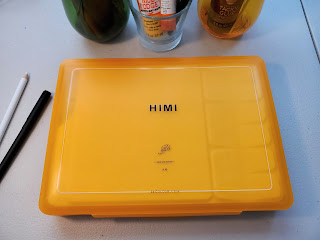This is the fourth in a series of reviews of the individual colors from the HIMI brand 24-color “jelly” gouache paint set. This review will concentrate on the HIMI Jade Green, Grass Green, and Yellow Green jelly gouache paint colors and will also include updates on my Star Trek painting and how my swatch chart is coming along.
Setting aside the mint green grass debacle (see the review of HIMI Gouache color 005 – Pale Green for that https://allsortsartbyali.blogspot.com/2023/09/himi-jelly-gouache-color-review-3-pale.html) for a while, I turned back to working on the background of the painting. I needed a line of trees in the background, and so I was looking for a green that was darker but very cool, since cool colors recede.
HIMI Jelly Gouache color no 002 – Jade Green
There was a color in the collection called Jade Green - this is HIMI gouache color 002. It is a very dark color with a very cool cast, kind of like the green version of the Acid Blue that I discussed in a previous post (https://allsortsartbyali.blogspot.com/2023/07/himi-jelly-gouache-color-review-white.html).
As with the other colors, it was very creamy in consistency once I had given it a good stir to get it well-blended. It was very dark, but gouache is easily lightened by diluting it with water or by mixing it with white or lighter colors. Since this was for the background and it's best to work thin-to-thick, I chose to simply dilute with water for the lighter bits. It made a good color for the background trees, so I went ahead and painted in the treeline and then added the Jade Green to my swatch charts.
HIMI Jelly Gouache color no 072 – Grass Green
Now that the trees were established in the background, I went back to working on the grass to complete the background of the picture. The obvious choice at this point was Grass Green, at which I had turned up my nose before. Not surprisingly, it ended up being an appropriate color for the grass, as you can see in this picture.
HIMI Jelly Gouache color no 018 – Yellow Green
I also added the color Yellow Green to highlight the areas where the sun would naturally be striking the grass, so that I could have a nice sunny meadow to compliment my bright blue sky. As you can see from the swatch chart at the top of the page, the Grass Green and the Yellow Green are extremely warm - that is, they have a lot of yellow in them - in contrast to the Jade Green and the Pale Green colors, which are extremely cool, meaning that they have a very blue undertone.
Now the background of the picture is pretty much complete, and I can move along to painting my characters!
For the original post describing the unboxing of the HIMI jelly gouache paint set, go here: https://allsortsartbyali.blogspot.com/2023/03/unboxing-himi-jelly-gouache-24-color-set.html
For the first review in the series, go here: https://allsortsartbyali.blogspot.com/2023/06/himi-jelly-gouache-color-review-1-sky.html
For regular shenanigans, please follow my Facebook page, https://www.facebook.com/allsortsofart























































